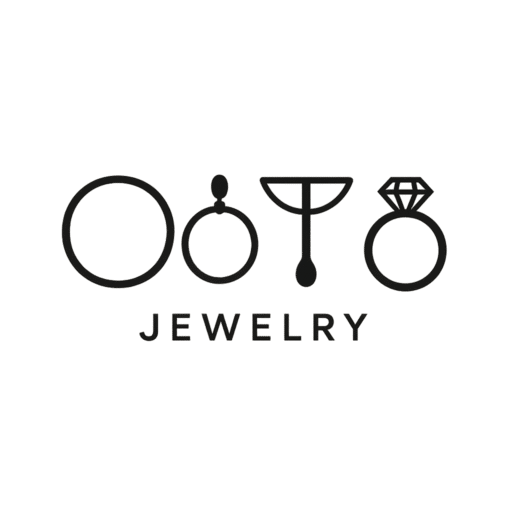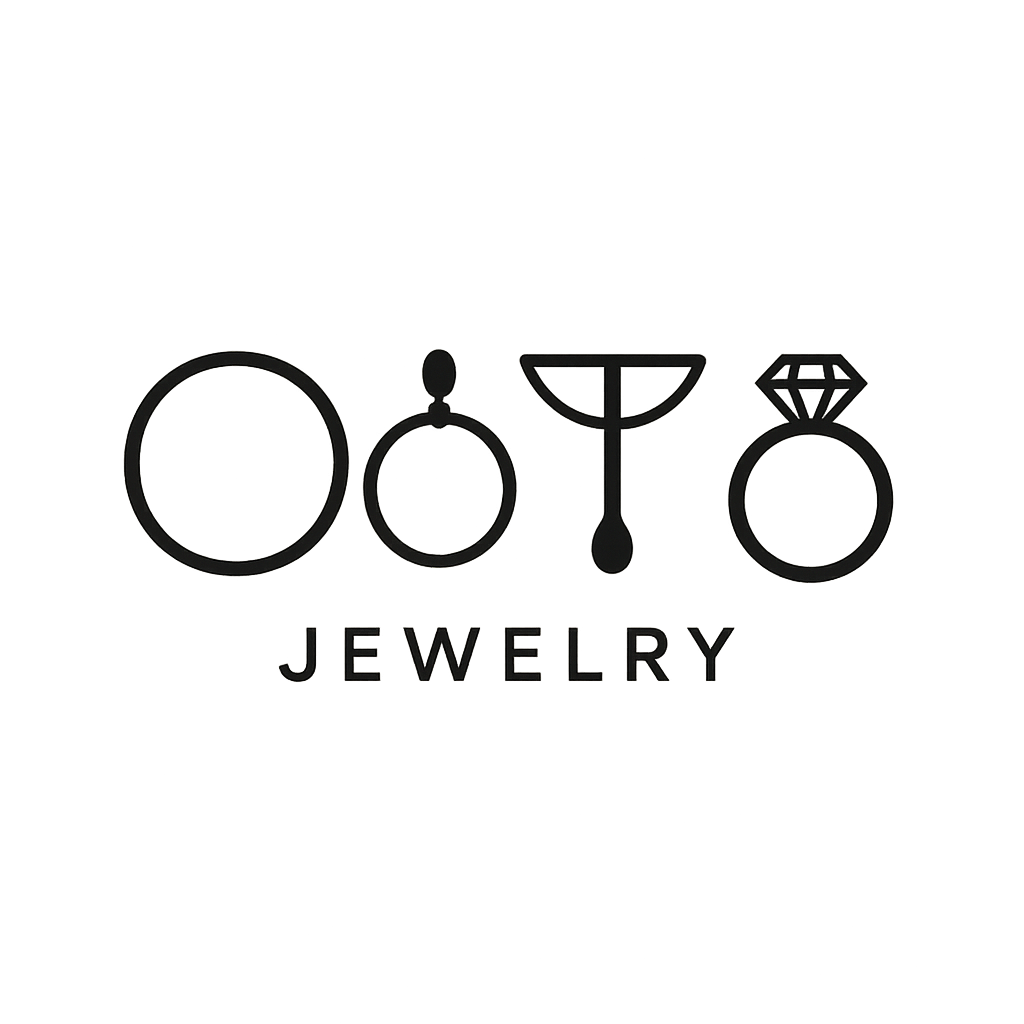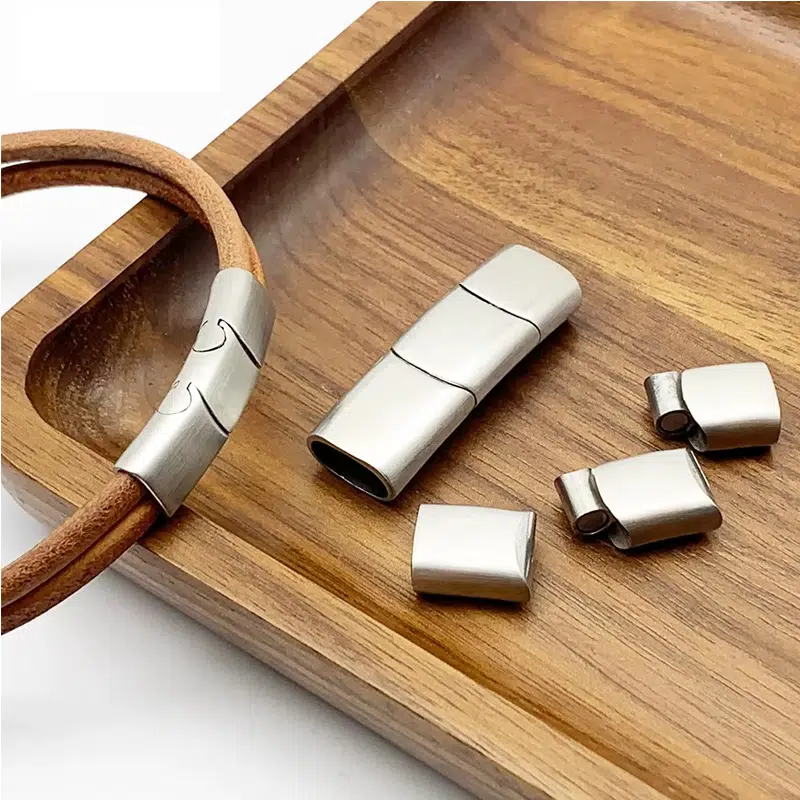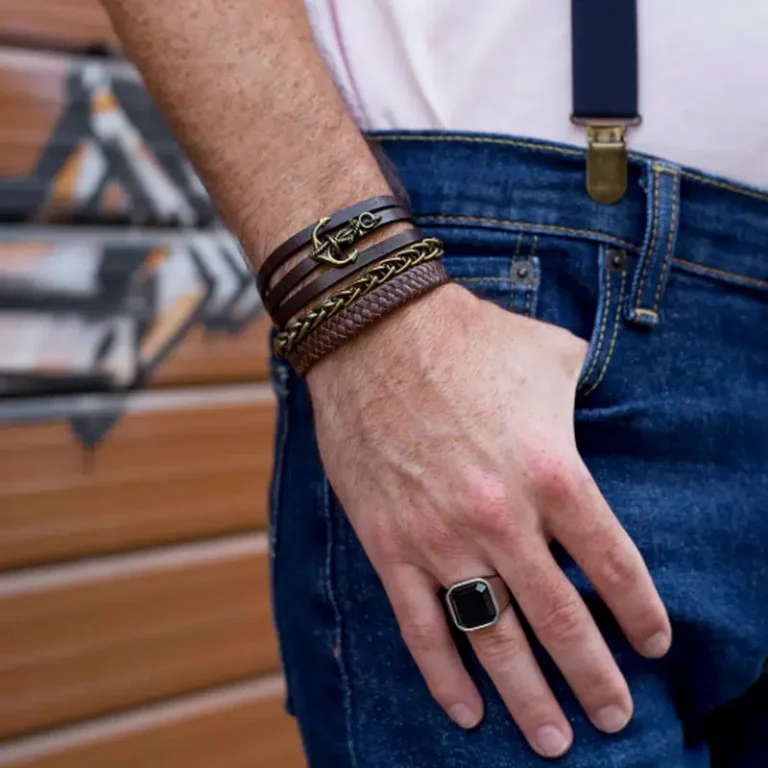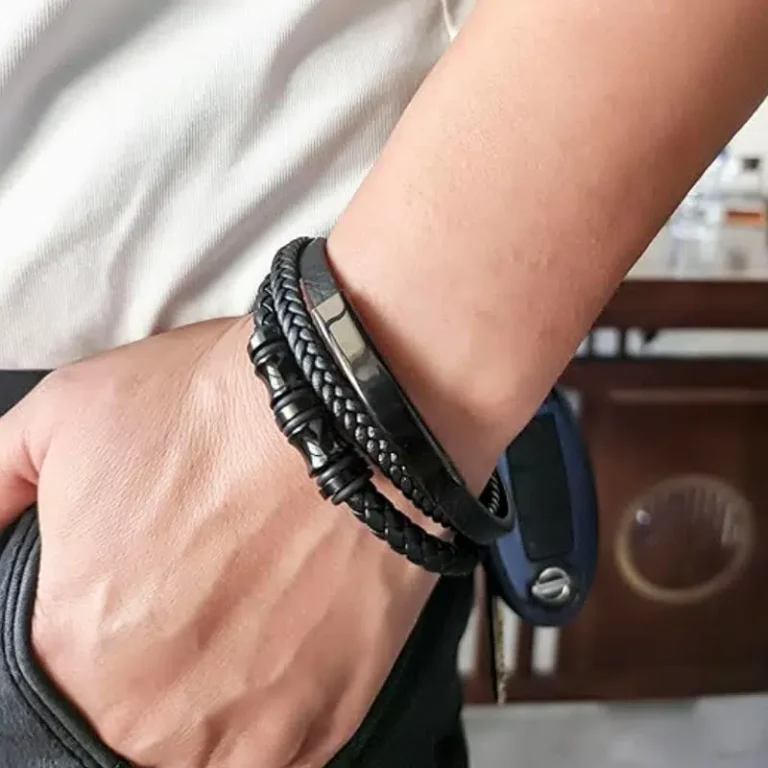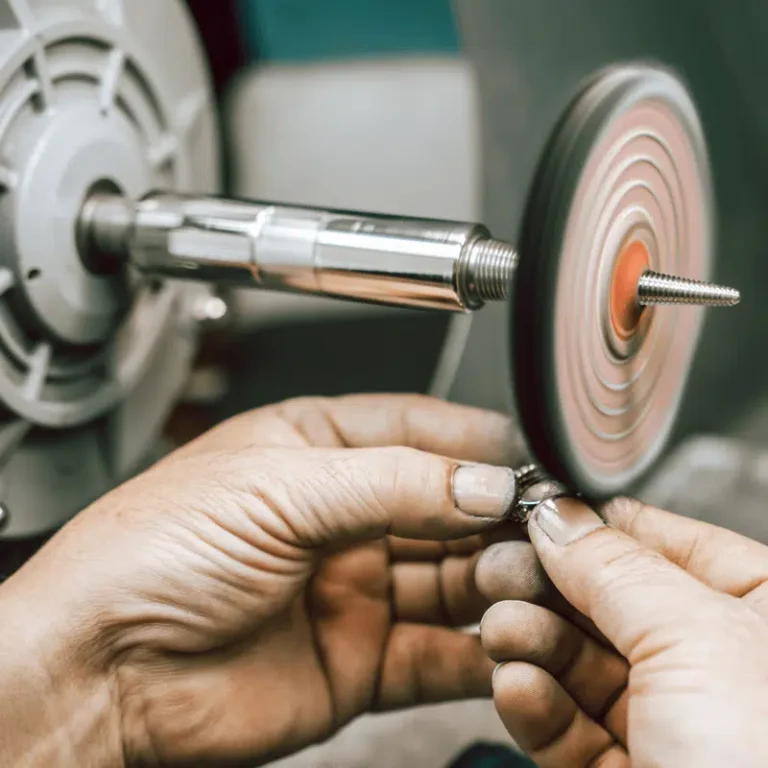Introduction
A clasp joins the two ends of your leather bracelet. The style you select alters both the appearance and the wearing of the bracelet. A heavy metal clasp imparts a rugged touch, while a small hidden clasp provides a sleek appearance. Some clasps can be fastened one-handed in a matter of seconds; other points require both hands and careful manipulation.
The guide covers six important kinds of leather bracelet clasp types and tells you what to look for to find those which suit your requirements and give you the look that you love.
Clasp Type 1: The Modern Convenience (Magnetic Clasps)
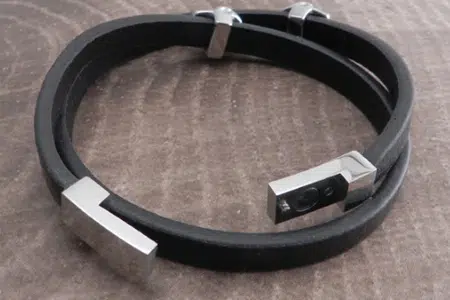
Magnetic clasps use two pieces that snap together with the use of strong magnets. They come in a cylindrical shape or rectangular shape and instantly connect when brought in close proximity to one another.
Best For
These clasps are best for use with jewelry bracelets made with thick braided leather bracelet or heavy-duty cord. The weight of thicker leather requires strong magnets to hold it together; thus, when manufacturing these leather bracelets, the manufacturers always use N52 magnets. N52 is the strongest grade of magnet and will hold well under normal wear and tear.
Pros
- You can put on the bracelet and take it off with one hand
- Fast release of clasp saves time when rushing
- Clasp appears clean and minimal with clasp closed
- No complicated mechanism to fumble with
Cons
- Weak magnets make security questionable
- Jewelry bracelet can come undone when snagged by something
- Not good for sports, gym workouts, or active jobs
- Strong magnets will interfere with certain medical devices
Clasp Type 2: The Classic Utility (Lobster Claw & Spring Ring)
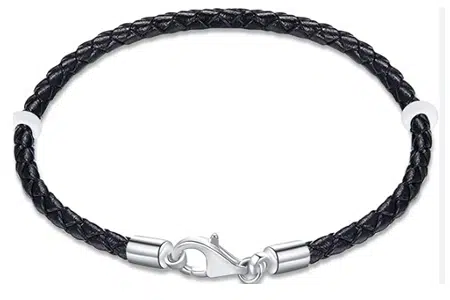
These are the standard clasps you will find on a chain. The lobster clasps have a spring-loaded arm that opens with a small lever you press. The spring ring is a complete circle that uses a similar spring mechanism.
Best For
These clasps work well with thin leather cording, multi-strand designs, or any bracelet that needs an adjustable length. You can attach them to different rings along the bracelet to make it either tighter or looser.
Pros
- Very secure and reliable for every day wear
- Will not come unfastened accidentally
- Cheap and available in many materials such as stainless steel or sterling silver.
- Easy to replace if they should become damaged.
Cons
- They require two hands to operate.
- The small levers may be hard to press.
- Less decorative than onther varieties.
- Can look plain on statement pieces.
Clasp Type 3: The Decorative Statement (Toggle Clasps)
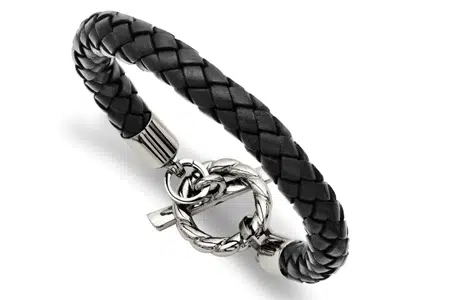
Toggle clasps consist of two parts, a T-shaped bar and a ring. You push the bar through the ring, then turn it sideways to secure the closure.
Best For
Casual, bohemian, or purposely oversized leather bracelets where the clasp itself is part of the design. The toggle rest on the edge and /or top of your wrist, as a decorative element.
Pros
- Highly decorative and gives character
- Easily manipulated by either hand
- Controls a very unique visual element
- Conveniently has many artistic designs
Cons
- Least secure of all classes of clasps
- The bar can slide back through if the bracelet is slack
- Not advisable for valuable bracelets
- Play, that will catch in clothing
Tips
Make sure that your leather bracelet fits there snug. The T-bar should not be able to slip back through the ring during normal motion. A well fitted toggle clasp will hold throughout the day.
Clasp Type 4: The Discreet Security (Slide/Box Clasps)
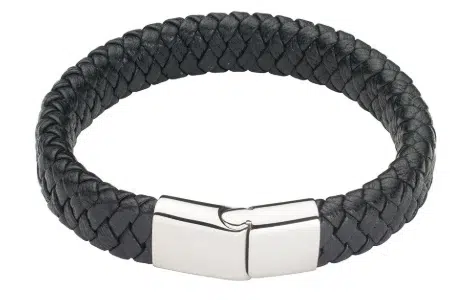
A tab is inserted into a rectangle box or tube for locking in place. Some of them locking in a mechanical fashion while others with magnets inside which keep the tab secured.
Best For
Multistrand of leather bands, cuff bracelets, or any design which requires hiding of the closure completely. These closures make for a seamless look from every angle.
Benefits
- Extremely strong and durable
- Gives a clean, finished look
- No part of the clasp mechanism reveals when worn
- Professional look for business settings
Disadvantages
- More expensive due to the complicated construction
- The magnetic types require strong N42 magnets
- May be difficult to open if mechanism is stiff
- Difficult to repair if broken.
Clasp Type 5: The Industrial Finish (Bayonet Clasp)
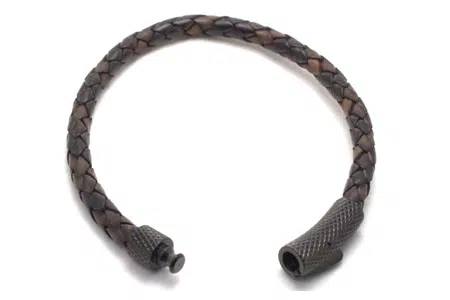
This decorative cylindrical clasp has one side that twists and goes into the other half. Once you have twisted and pushed, it is held in by an internal locking pin or spring device.
Best For
Round leather cords, sleek modern designs, and high-end men’s jewelry, where it is worth keeping a clean transition between cord and clasp. The line of the cord continues without breaking the visual line for a smooth look.
Pros
- Extremely secure when locked
- Smooth, continuous-looking effect
- Modern look fits in with present-day trends in jewelry
- Conceals the termination of the leather cord perfectly
Cons
- Twist-push is a little awkward at first
- Needs practice for quick opening and closing
- Needs accurate measurements to get a good fit
- More expensive than simple clasps
Clasp Type 6: The Minimalist Simplicity (Hook & Loop / S-Hook)
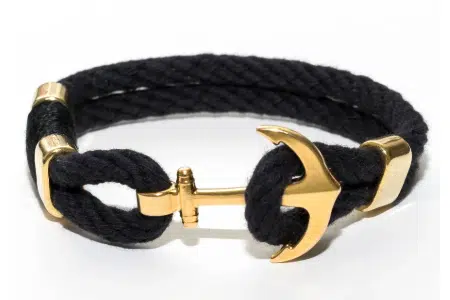
Another design is a fairly simple S or J-shaped wire hook that fits into a ring or loop at the other end of the leather. This fastening is one of the oldest forms of clasps that are still in use. It is best suited to simple single-leather strands since it has a simple hand-worked look. They show up well on natural, untreated leather so that its texture is seen.
Pros
- Old-fashioned, natural-looking leather blends
- Very durable—no moving parts to break
- Small design—no opportunity for it to get in the way
- Simple to make or replace
Cons
- Fastening requires two hands
- May come undone, if leather is sharply pulled
- Not as secure as enclosed fastenings
- Hook is subject to bending over time.
Making Your Choice: Three Key Considerations
Durability & Material
Choose stainless steel clasps for daily wear. This type of metal resists corrosion and retains its strength over a long period .nd use. Avoid plated brass for bracelets which you wear for long periods. The brass will be exposed due to the wearing off of plating.
Security is preferable to convenience if you wear expensive bracelets or cannot afford to lose them. Lobster clasps, box clasps, bayonet clasps afford the maximum security. Magnetic clasps afford convenience and safety but lack some security.
Aesthetics & Style
Be sure your clasp’s finish and size correspond with your leather. A large, chunky cuff bracelet calls for a substantial clasp, such as a magnetic or box clasp, to balance the heavier appearance of the thick leather. A fine leather cord will look better with a smaller, classic clasp such as a lobster claw or hook.
The metal finish and color of the clasp should blend well with your other jewelry pieces. If you wear gold and silver together, choose a clasp that works with both.
Ease of Use
Do you need a closure that can be closed with one hand? Magnetic clasps are great for this, as you can fasten them while carrying groceries or a cup of coffee. If you prefer the maximum security that comes from closed closures that require both hands, lobster claws, bayonet clasps, and hook clasps can be more effective.
Think about arthritis or hand mobility here, too. Magnetic clasps require the least amount of dexterity, while spring-loaded closures may be difficult to open and close if the hands aren’t as nimble as they once were.
Conclusion
The right clasp balances security with the look you want. Thick leather needs strong clasps, thin cords need delicate ones.
OOTB jewelry is a China leather bracelet manufacturer; we own our factory and can offer you over 500 different leather bracelets for both men and women in different styles and price ranges. Contact us to customize leather bracelets with the perfect clasp for your needs.
